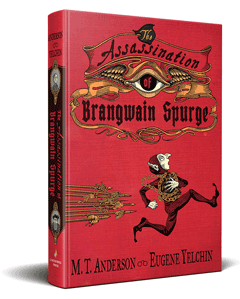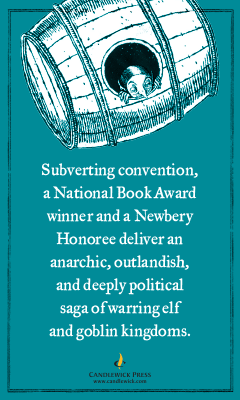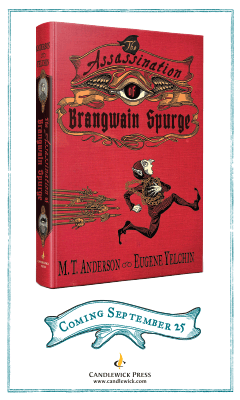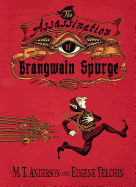The Assassination of Brangwain Spurge
by M.T. Anderson, illus. by Eugene Yelchin
The Assassination of Brangwain Spurge, M.T. Anderson and Eugene Yelchin's first collaboration for middle-grade readers, is an intelligent, captivating and hilarious tale that uses fantasy characters and settings to give readers an up-close look at how the victors write the histories.
The work begins with a prologue comprised entirely of Yelchin's detailed pen-and-ink and digital illustrations. An egg-shaped container, liberally studded with jewels, hinges open to reveal a shining gemstone, inside of which an army battles. A "top secret transmission" follows, showing an elf in a giant barrel being handed the container. The barrel is mounted on a massive slingshot and thrown into the sky--it soars out of Elfland, over a great chasm and from day into night, before it is snatched mid-flight by a three-headed flying creature.
A letter to the elf king from Lord Ysoret Clivers gives the reader more information. When the elves "were digging the king's new wading pool, they found some old, buried goblin artifact--a giant gemstone carved with some kind of... [t]ypical goblin story: lots of beheadings." The elf king wants this gemstone to be given to Ghohg the Evil One, king of the goblins, "as a sign that elfish-goblin relations have improved in the last five years, since the truce." And what better emissary than a historian? Magister Brangwain Spurge, whom Clivers and his friends had mocked mercilessly as a child for being a "[s]hrimpy little chap" with "[a]rms wobbly like kelp" and a "[f]ishy sort of face," is chosen as envoy and shot "into the dark heart of the kingdom of the goblins." Spurge knows delivering the artifact is only part of the job--he is also expected to act as a spy and will magically send secret transmissions from the goblin homeland back to elf HQ.
Meanwhile, Werfel the Archivist, goblin historian at the Court of the Mighty Ghohg, is preparing for Spurge's visit. It's Werfel's job to host the elfin emissary, and goblins have "a strong code of hospitality. Once a goblin invite[s] someone across the threshold into their house, it [is] their duty to serve and protect their guest, no matter what." Which means that Werfel is extremely anxious. Beyond being a kind and generous host, he is a scholar and desperately wants to create a "union of elfin and goblin knowledge." But elf/goblin relations have been... tough... since the elves started (and won) a war in order to steal the goblin homeland and force goblinkind across the Bonecruel Mountains. Hosting an elf is intense business. And, Werfel wonders, will the elf like the hospitality chocolates he placed on his bed? Wait--are elves allergic to chocolate?
Spurge arrives, utterly convinced of his own importance and the significance of his mission. He sees the goblins as inferior to elves, brutish creatures with weird traditions and gross habits. And what Spurge sees is important--his transmissions back to HQ are purely visual and reflect "whatever he pictures in his mind's eye.... his image of things." Chapters alternate between Werfel's desperate attempts to please his snobby, scornful guest (in text) and the same scenes played out visually through the contemptuous lens of the elf. Disagreements and misunderstanding abound, many humorous (Spurge has difficulty understanding how goblins use insults to show deep affection), some a product of elfin bigotry (a goblin's shed skin is a "treasured possession" but Spurge finds the practice of keeping them "lying around" to be "[d]isgusting"). As Werfel and Spurge wait for Ghohg to give them an audience, Spurge makes enemies and a treacherous elfin plot is uncovered.
Anderson (Fatal Throne) and Yelchin's (Pip & Pup) amusing, compelling journey into Tolkien-styled fantasy is both extremely nuanced and completely over-the-top. It is, in Anderson's words, "a really tragic meditation on how societies that have been trained to hate each other for generations can actually come to see eye to eye." Or, perhaps it is, according to Yelchin, a "laugh-out-loud misadventure of two fools blinded by ideology and propaganda." It is also a fantastically sharp depiction of how what we see is not always what we get, and how personal perception can shape not just our own reality, but the experience and understanding of those around us. Anderson and Yelchin work cleverly together, giving close readers tons of things to pick apart between illustration and text. And, while the tones of the illustration and text are different from the beginning--the art dark and scary, the text light, friendly and upbeat--it is not immediately clear that Spurge's impressions differ from the reality. As this creative concept builds, a slow understanding dawns, and every reader will be able to literally see how Spurge's thoughts and opinions affect his experience--and how his experience affects his thoughts and opinions. The Assassination of Brangwain Spurge is a work with layers, secrets and hidden gems that will certainly call for many rereads. --Siân Gaetano, children's and YA editor, Shelf Awareness









